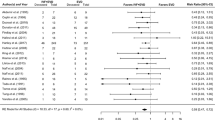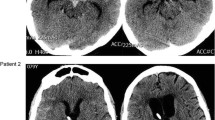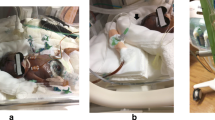Abstract
This paper aims to review current literature on the treatment of acute intraventricular hemorrhage in adults with intraventricular infusion of fibrinolytic agents. A literature search on the topics of “intraventricular hemorrhage” or “intracerebral hemorrhage” with “thrombolytic therapy”, “fibrinolytic therapy”, “urokinase”, “streptokinase”, “tissue plasminogen activator” or “tPA” covering the years 1966–1997 was carried out electronically. This was supplemented by searching the reference lists of the identified articles. Articles regarding exclusively intracerebral hemorrhage or hematoma, neonatal intraventricular hemorrhage, non-therapeutic issues, and laboratory research were excluded. The included articles are summarized in evidence and evaluation tables. Six articles evaluating the treatment of intraventricular hemorrhage in adults with intraventricular fibrinolytic agents were identified. One reports a small randomized clinical trial including 16 patients and appears to show a statistically insignificant preference for urokinase treatment. Five other reports present case series for which a total of 58 patients were exposed to either streptokinase, urokinase, or recombinant tissue plasminogen activator (rt-PA) and suggest good outcome. Two of them were with non-randomized retrospective or prospective controls, and three have no controls. Despite important limitations, all reports suggest that blood is more rapidly cleared from the ventricles and outcome is better when administering a fibrinolytic agent intraventricularly. While the experience presented in these papers suggests that intraventricular administration of fibrinolytic agents may be associated with fewer complications, more rapid clearing of blood from the ventricles, less late hydrocephalus, and better long-term outcome than is seen in patients treated with ventricular drainage alone, it is insufficient to recommend such treatment as a matter of policy. Substantial methodologic flaws render these findings suggestive at best. If the suggestive findings of these studies were confirmed in well-designed randomized clinical trials, an important impact on clinical practice could be expected.
Similar content being viewed by others
Papers reviewed
Shen PH, Matsuoka Y, Kawajiri K, Kanai M, Hoda K, Yamamoto S, Nishimura S (1990) Treatment of intraventricular hemorrhage using urokinase. Neurol Med Chir (Tokyo) 30:329–333
Todo T, Usui M, Takakura K (1991) Treatment of severe intraventricular hemorrhage by intraventricular infusion of urokinase. J Neurosurg 74:81–86
Mayfrank L, Lippitz B, Groth M, Bertalanffy H, Gilsbach JM (1993) Effect of recombinant tissue plasminogen activator on clot lysis and ventricular dilatation in the treatment of severe intraventricular haemorrhage. Acta Neurochir (Wien) 122:32–38
Rainov NG, Burkert WL (1995) Urokinase infusion for severe intraventricular haemorrhage. Acta Neurochir (Wien) 134:55–59
Rohde V, Schaller C, Hassler WE (1995) Intraventricular recombinant tissue plasminogen activator for lysis of intraventricular haemorrhage. J Neurol Neurosurg Psychiatry 58:447–451
Akdemir H, Selcuklu A, Pasaoglu A, Oktem IS, Kavuncu I (1995) Treatment of severe intraventricular hemorrhage by intraventricular infusion of urokinase. Neurosurg Rev 18:95–100
Further reading
Graeb DA, Robertson WD, Lapointe JS, Nugent RA, Harrison PB (1982) Computed tomographic diagnosis of intraventricular hemorrhage. Radiology 143:91–96
Jaddad AR, Moore RA, Carroll D, Jenkinson C, Reynolds DJM, Gavaghan DJ, McQuay HJ (1996) Assessing the quality of reports of randomized clinical trials: is blinding necessary? Control Clin Trials 17:1–12
Leroux PD, Haglund MM, Newell DW, Grady MS, Winn HR (1992) Intraventricular haemorrhage in blunt head trauma: an analysis of 43 cases. Neurosurgery 31:678–685
Sackett DL, Haynes RB, Guyatt GH, Tugwell P (1991) Clinical epidemiology. A basic science for clinical medicine, 2nd edn. Little, Brown & Co, Boston Toronto London, pp 187–248
Author information
Authors and Affiliations
Corresponding author
Rights and permissions
About this article
Cite this article
Haines, S.J., Lapointe, M. Fibrinolytic agents in the treatment of intraventricular hemorrhage in adults. Critical Reviews in Neurosurgery 8, 169–175 (1998). https://doi.org/10.1007/s003290050074
Published:
Issue Date:
DOI: https://doi.org/10.1007/s003290050074




